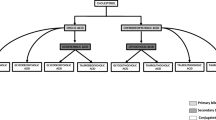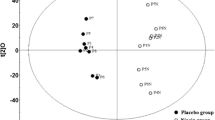Abstract
Background
Obesity is related to cardiovascular risk factors (CVRF) such as dyslipidemia, diabetes, and hypertension, which increase mortality. Basic lipid determinations could underestimate the true atherogenic risk of patients and the impact of bariatric surgery. The objective of the study is to demonstrate the change in the advanced molecular profile of lipoproteins determined by nuclear magnetic resonance spectroscopy in plasma after bariatric surgery, thus reducing the risk of cardiovascular disease.
Material and Methods
Descriptive, observational, and prospective study in obese patients undergoing bariatric surgery. Advanced lipid profile was analyzed in plasma from the immediate preoperative period and at the 18th postoperative month by sending samples and performing plasma magnetic resonance spectroscopy in the BiosferTreslab® laboratory.
Results
Fifty-two patients were included. Average age of 46.3 years; 63.46% were women, 36.54% men. The average BMI was 43.57; the abdominal perimeter 133.50 cm; 32.6% were diabetics under medical treatment, 44.23% hypertensive, and 19.23% smokers; 86.53% of the patients presented alterations in at least one of the analytical parameters in the lipid study. Twenty-nine (55.7%) underwent banded gastric bypass (PGB), 19.23% underwent GBP, and 17.31% vertical gastrectomy. The rest were revision surgeries, two BPG-A and two biliopancreatic diversions after GV. All patients presented some improvement in advanced molecular profile of lipoproteins. Twenty percent of the patients normalized all the parameters.
Conclusions
Bariatric surgery improves advanced molecular profile of lipoproteins, decreasing CVRF. Analysis of the characteristics of lipoprotein particles by NMR spectrometry is optimal for studying lipoprotein metabolism in patients undergoing bariatric surgery.
Graphical Abstract



Similar content being viewed by others
References
Kelly T, Yang W, Chen CS, et al. Global burden of obesity in 2005 and projections to 2030. Int J Obes. 2008;32(9):1431–7.
Berrington de Gonzalez A, Hartge P, Cerhan JR, et al. Body-mass index and mortality among 1. 46 million white adults. N Engl J Med. 2010;363:2211–9.
Yumuk V, Tsigos C, Fried M, et al. European guidelines for obesity management in adults. Obes Facts. 2015;8:402–24.
Susana C, Flávio R, Cátia F, et al. Weight loss achieved by bariatric surgery modifies high-density lipoprotein subfractions and low-density lipoprotein oxidation towards atheroprotection. Clin Biochem. 2019;63:46–53.
Rader DJ, Daugherty A. Translating molecular discoveries into new therapies for atherosclerosis. Nature. 2008;451:904–13.
Esteve E, Ricart W, Fernandez-Real JM. Dyslipidemia and inflammation: an evolutionary conserved mechanism. Clin Nutr. 2005;24:16–31.
Kang JH, Le QA. Effectiveness of bariatric surgical procedures: a systematic review and network meta-analysis of randomized controlled trials. Medicine (Baltimore). 2017;96(46):e8632.
Bays H, Kothari SN, Azagury DE, et al. Lipids and bariatric procedures Part 2 of 2: scienti fi c statement from the American Society for Metabolic and Bariatric Surgery (ASMBS), the National Lipid Association (NLA), and Obesity Medicine Association (OMA). Surg Obes Relat Dis. 2016;12(3):468–95.
Ikramuddin S, Korner J, Lee WJ, et al. Roux-en-Y gastric bypass vs intensive medical management for the control of type 2 diabetes, hypertension, and hyperlipidemia: the Diabetes Surgery Study randomized clinical trial. JAMA. 2013;309(21):2240–9.
Amor AJ, Pinyol M, Solà E, et al. Relationship between noninvasive scores of nonalcoholic fatty liver disease and nuclear magnetic resonance lipoprotein abnormalities: a focus on atherogenic dyslipidemia. J Clin Lipidol. 2017;11(2):551-561.e7.
Taskien MR. Diabetic dyslipidemia. Atherosclerosis. 2002;3(1):47–51.
Nguyen NT, Varela E, Sabio A, et al. Resolution of hyperlipidemia after laparoscopic Roux-en-Y gastric bypass. J Am Coll Surg. 2006;203:24–9.
Bays HE, Toth PP, Kris-Etherton PM, et al. Obesity, adiposity, and dyslipidemia: a consensus statement from the National Lipid Association. J Clin Lipidol. 2013;7:304–83.
Holmes MV, Millwood IY, Kartsonaki C, et al. Lipids, lipoproteins, and metabolites and risk of myocardial infarction and stroke. J Am Coll Cardiol. 2018;71:620–32.
Mora S, Glynn RJ, Ridker PM. High-density lipoprotein cholesterol, size, particle number, and residual vascular risk after potent statin therapy. Circulation. 2013;128:1189–97.
Aday AW, Lawler PR, Coomk NR, et al. Lipoprotein particle profiles, standard lipids, and peripheral artery disease incidence - prospective data from the Women’s Health Study. Circulation. 2018;138(21):2330–41.
Varbo A, Nordestgaard BG. Directly measured vs. calculated remnant cholesterol identifies additional overlooked individuals in the general population at higher risk of myocardial infarction. Eur Heart J. 2021;42(47):4833–43.
Pichler G, Amigo N, Tellez-Plaza M, et al. LDL particle size and composition and incident cardiovascular disease in a South-European population: the Hortega-Liposcale Follow-up Study. Int J Cardiol. 2018;264:172–8.
Kjellmo CA, Karlsson H, Nestvold TK, et al. Bariatric surgery improves lipoprotein profile in morbidly obese patients by reducing LDL cholesterol, apoB, and SAA/PON1 ratio, increasing HDL cholesterol, but has no effect on cholesterol efflux capacity. J Clin Lipidol. 2018;12(1):193–202.
Cunha FM, Oliveira J, Preto J, et al. The effect of bariatric surgery type on lipid profile: an age, sex, body mass index and excess weight loss matched study. Obes Surg. 2016;26(5):1041–7.
Buchwald H, Avidor Y, Braunwald E, et al. Bariatric surgery: a systematic review and meta-analysis. JAMA. 2004;292:1724–37.
González Arnáiz E, Ballesteros Pomar M, González Roza L, et al. Evaluation of lipoprotein profile and residual risk three years after bariatric surgery. Obes Surg. 2021;31:4033–44.
Funding
The study was financed with assistance from the Foundation Research Grant from the Spanish Society of Obesity Surgery (FUNSECO) awarded in 2021.
Author information
Authors and Affiliations
Corresponding author
Ethics declarations
Human and Animal Rights/Ethics Approval
The study complied with the rules of Good Clinical Practice and was approved by the Medical Research Ethics Committee of the 12 de Octubre University Hospital.
Informed Consent
Informed consent was obtained from all individual participants included in the study.
Conflict of Interest
The authors declare no competing interests.
Additional information
Publisher's Note
Springer Nature remains neutral with regard to jurisdictional claims in published maps and institutional affiliations.
Rights and permissions
Springer Nature or its licensor (e.g. a society or other partner) holds exclusive rights to this article under a publishing agreement with the author(s) or other rightsholder(s); author self-archiving of the accepted manuscript version of this article is solely governed by the terms of such publishing agreement and applicable law.
About this article
Cite this article
Pérez Zapata, A.I., Varela Rodríguez, C., Martín-Arriscado Arroba, C. et al. Advanced Lipoproteins and Lipidomic Profile in Plasma Determined by Nuclear Magnetic Resonance Before and After Bariatric Surgery. OBES SURG 33, 3981–3987 (2023). https://doi.org/10.1007/s11695-023-06904-9
Received:
Revised:
Accepted:
Published:
Issue Date:
DOI: https://doi.org/10.1007/s11695-023-06904-9




